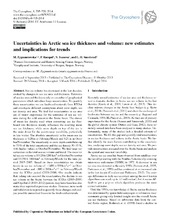| dc.contributor.author | Zygmuntowska, Marta | eng |
| dc.contributor.author | Rampal, Pierre | eng |
| dc.contributor.author | Ivanova, Natalia | eng |
| dc.contributor.author | Smedsrud, Lars Henrik | eng |
| dc.date.accessioned | 2014-06-30T09:37:51Z | |
| dc.date.available | 2014-06-30T09:37:51Z | |
| dc.date.issued | 2014-04-22 | eng |
| dc.identifier.issn | 1994-0416 | en_US |
| dc.identifier.uri | https://hdl.handle.net/1956/8033 | |
| dc.description.abstract | Sea ice volume has decreased in the last decades, evoked by changes in sea ice area and thickness. Estimates of sea ice area and thickness rely on a number of geophysical parameters which introduce large uncertainties. To quantify these uncertainties we use freeboard retrievals from ICESat and investigate different assumptions about snow depth, sea ice density and area. We find that uncertainties in ice area are of minor importance for the estimates of sea ice volume during the cold season in the Arctic basin. The choice of mean ice density used when converting sea ice freeboard into thickness mainly influences the resulting mean sea ice thickness, while snow depth on top of the ice is the main driver for the year-to-year variability, particularly in late winter. The absolute uncertainty in the mean sea ice thickness is 0.28m in February/March and 0.21m in October/ November. The uncertainty in snow depth contributes up to 70% of the total uncertainty and the ice density 30–35 %, with higher values in October/November. We find large uncertainties in the total sea ice volume and trend. The mean total sea ice volume is 10120±1280 km³ in October/November and 13250±1860 km³ in February/March for the time period 2005–2007. Based on these uncertainties we obtain trends in sea ice volume of −1450±530 km³ a−1 in October/ November and −880±260 km³ a−1 in February/March over the ICESat period (2003–2008). Our results indicate that, taking into account the uncertainties, the decline in sea ice volume in the Arctic between the ICESat (2003–2008) and CryoSat-2 (2010–2012) periods may have been less dramatic than reported in previous studies. However, more work and validation is required to quantify these changes and analyse possible unresolved biases in the freeboard retrievals. | en_US |
| dc.language.iso | eng | eng |
| dc.publisher | Copernicus Publications on behalf of the European Geosciences Union | en_US |
| dc.relation.ispartof | <a href="http://hdl.handle.net/1956/8035" target="blank">Arctic sea ice altimetry - advances and current uncertainties</a> | en_US |
| dc.rights | Attribution CC BY | eng |
| dc.rights.uri | http://creativecommons.org/licenses/by/3.0/ | eng |
| dc.title | Uncertainties in Arctic sea ice thickness and volume: new estimates and implications for trends | en_US |
| dc.type | Peer reviewed | |
| dc.type | Journal article | |
| dc.description.version | publishedVersion | en_US |
| dc.rights.holder | Copyright Author(s) 2014 | en_US |
| dc.identifier.doi | https://doi.org/10.5194/tc-8-705-2014 | |
| dc.identifier.cristin | 1129101 | |
| dc.source.journal | The Cryosphere | |
| dc.source.40 | 8 | |
| dc.source.pagenumber | 705-720 | |

